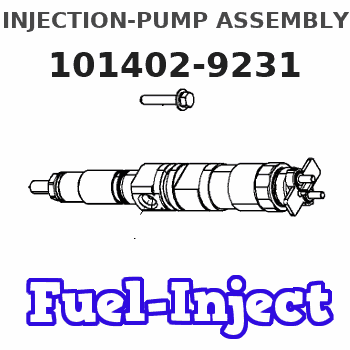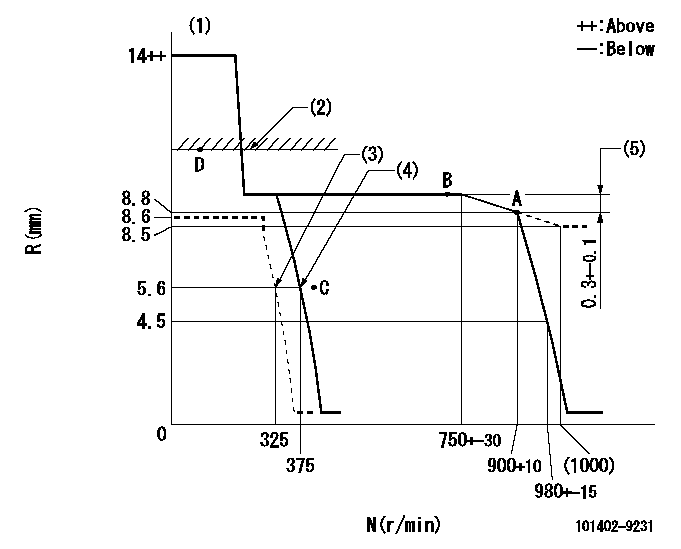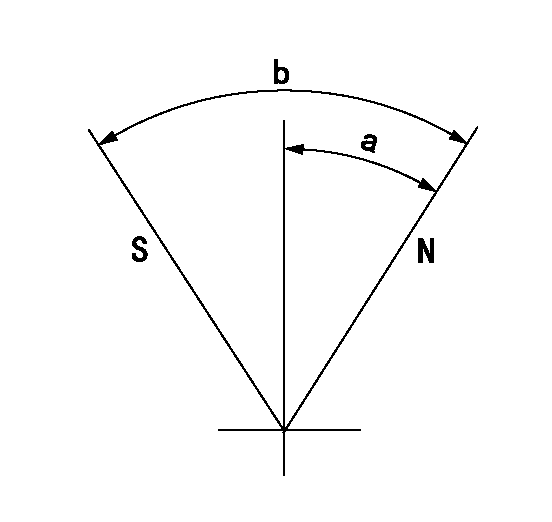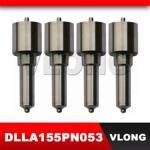Information injection-pump assembly
ZEXEL
101402-9231
1014029231
MITSUBISHI-HEAV
3426100090
3426100090

Rating:
Service parts 101402-9231 INJECTION-PUMP ASSEMBLY:
1.
_
5.
AUTOM. ADVANCE MECHANIS
6.
COUPLING PLATE
7.
COUPLING PLATE
8.
_
9.
_
11.
Nozzle and Holder
12.
Open Pre:MPa(Kqf/cm2)
21.6(220)
15.
NOZZLE SET
Include in #1:
101402-9231
as INJECTION-PUMP ASSEMBLY
Include in #2:
104741-3950
as _
Cross reference number
ZEXEL
101402-9231
1014029231
MITSUBISHI-HEAV
3426100090
3426100090
Zexel num
Bosch num
Firm num
Name
Calibration Data:
Adjustment conditions
Test oil
1404 Test oil ISO4113 or {SAEJ967d}
1404 Test oil ISO4113 or {SAEJ967d}
Test oil temperature
degC
40
40
45
Nozzle and nozzle holder
105780-8140
Bosch type code
EF8511/9A
Nozzle
105780-0000
Bosch type code
DN12SD12T
Nozzle holder
105780-2080
Bosch type code
EF8511/9
Opening pressure
MPa
17.2
Opening pressure
kgf/cm2
175
Injection pipe
Outer diameter - inner diameter - length (mm) mm 6-2-600
Outer diameter - inner diameter - length (mm) mm 6-2-600
Overflow valve
131424-5720
Overflow valve opening pressure
kPa
255
221
289
Overflow valve opening pressure
kgf/cm2
2.6
2.25
2.95
Tester oil delivery pressure
kPa
157
157
157
Tester oil delivery pressure
kgf/cm2
1.6
1.6
1.6
Direction of rotation (viewed from drive side)
Right R
Right R
Injection timing adjustment
Direction of rotation (viewed from drive side)
Right R
Right R
Injection order
1-3-4-2
Pre-stroke
mm
3.6
3.55
3.65
Beginning of injection position
Drive side NO.1
Drive side NO.1
Difference between angles 1
Cal 1-3 deg. 90 89.5 90.5
Cal 1-3 deg. 90 89.5 90.5
Difference between angles 2
Cal 1-4 deg. 180 179.5 180.5
Cal 1-4 deg. 180 179.5 180.5
Difference between angles 3
Cyl.1-2 deg. 270 269.5 270.5
Cyl.1-2 deg. 270 269.5 270.5
Injection quantity adjustment
Adjusting point
A
Rack position
8.8
Pump speed
r/min
900
900
900
Average injection quantity
mm3/st.
74.6
73.6
75.6
Max. variation between cylinders
%
0
-2.5
2.5
Basic
*
Fixing the lever
*
Injection quantity adjustment_02
Adjusting point
-
Rack position
5.9+-0.5
Pump speed
r/min
400
400
400
Average injection quantity
mm3/st.
8
6.7
9.3
Max. variation between cylinders
%
0
-14
14
Fixing the rack
*
Remarks
Adjust only variation between cylinders; adjust governor according to governor specifications.
Adjust only variation between cylinders; adjust governor according to governor specifications.
Injection quantity adjustment_03
Adjusting point
D
Rack position
-
Pump speed
r/min
100
100
100
Average injection quantity
mm3/st.
60
60
65
Fixing the lever
*
Rack limit
*
Test data Ex:
Governor adjustment

N:Pump speed
R:Rack position (mm)
(1)Target notch: K
(2)RACK LIMIT
(3)Set idle sub-spring
(4)Main spring setting
(5)Rack difference between N = N1 and N = N2
----------
K=15 N1=900r/min N2=700r/min
----------
----------
K=15 N1=900r/min N2=700r/min
----------
Speed control lever angle

F:Full speed
I:Idle
(1)Stopper bolt setting
----------
----------
a=(2deg)+-5deg b=(20deg)+-5deg
----------
----------
a=(2deg)+-5deg b=(20deg)+-5deg
Stop lever angle

N:Pump normal
S:Stop the pump.
----------
----------
a=26.5deg+-5deg b=53deg+-5deg
----------
----------
a=26.5deg+-5deg b=53deg+-5deg
Timing setting

(1)Pump vertical direction
(2)Position of camshaft's key groove at No 1 cylinder's beginning of injection
(3)-
(4)-
----------
----------
a=(60deg)
----------
----------
a=(60deg)
Information:
Recommended Procedure With Chassis Dynamometer
Possible Causes/Corrections
Minor Operating Faults/To help identify a problem before a more involved troubleshooting procedure is started, follow the procedure given in the PRIMARY ENGINE CHECKS section. Fuel Ratio Control Out of Adjustment or Bad/Follow the procedure in the Testing and Adjusting section of this Service Manual. Check Engine Performance/Do a Power Analysis report (PAR), Level II, to check engine performance. See Special Instruction, Form No. SEHS8025 and SEHS7886 for the tooling and procedures to use. Be sure to make a record of the temperatures for inlet air, fuel (at filter base), lubricating oil and coolant. Fuel Settings Not Correct/If the Power Analysis Report indicates a problem, the governor fuel settings should be verified. See the Testing and Adjusting section of this Service Manual for the necessary procedures. Also, refer back to the information learned earlier (see OWNER/OPERATOR INPUT section) about the truck specifications and application and judge whether or not the engine is performing as expected or customer expectation is realistic. Bad Fuel Nozzle(s)/Remove the fuel nozzles and test as in the Testing and Adjusting section of this Service Manual.Recommended Procedure Without Chassis Dynamometer
Possible Causes/Corrections
Minor Operating Faults/To help identify a problem before a more involved troubleshooting procedure is started, follow the procedure given in the PRIMARY ENGINE CHECKS section. Fuel Ratio Control Out of Adjustment or Bad/Follow the procedure in the Testing and Adjusting section of this Service Manual. Fuel Injection Timing Not Correct/Follow the procedures in the Testing and Adjusting section of this Service Manual. Check Engine Performance/Install the tooling and follow the procedure given in the ROAD TEST section. Fuel Settings Not Correct/If the Road Test indicates a problem, the governor fuel settings should be verified. See the Testing and Adjusting section of this Service Manual for the necessary procedures. Also, refer back to the information learned earlier (see OWNER/OPERATOR INPUT section) about the truck specifications and application and judge whether or not the engine is performing as expected or customer expectation is realistic. Any Further Diagnosis Must Be Done On A Chassis Dynamometer/If the fuel settings are correct and the above procedures have been followed without finding the problem a Power Analysis Report (PAR), Level II, must be done on the engine. See Special Instruction, Form Nos. SEHS8025 and SEHS7886 for the correct tools and procedures to use.
Possible Causes/Corrections
Minor Operating Faults/To help identify a problem before a more involved troubleshooting procedure is started, follow the procedure given in the PRIMARY ENGINE CHECKS section. Fuel Ratio Control Out of Adjustment or Bad/Follow the procedure in the Testing and Adjusting section of this Service Manual. Check Engine Performance/Do a Power Analysis report (PAR), Level II, to check engine performance. See Special Instruction, Form No. SEHS8025 and SEHS7886 for the tooling and procedures to use. Be sure to make a record of the temperatures for inlet air, fuel (at filter base), lubricating oil and coolant. Fuel Settings Not Correct/If the Power Analysis Report indicates a problem, the governor fuel settings should be verified. See the Testing and Adjusting section of this Service Manual for the necessary procedures. Also, refer back to the information learned earlier (see OWNER/OPERATOR INPUT section) about the truck specifications and application and judge whether or not the engine is performing as expected or customer expectation is realistic. Bad Fuel Nozzle(s)/Remove the fuel nozzles and test as in the Testing and Adjusting section of this Service Manual.Recommended Procedure Without Chassis Dynamometer
Possible Causes/Corrections
Minor Operating Faults/To help identify a problem before a more involved troubleshooting procedure is started, follow the procedure given in the PRIMARY ENGINE CHECKS section. Fuel Ratio Control Out of Adjustment or Bad/Follow the procedure in the Testing and Adjusting section of this Service Manual. Fuel Injection Timing Not Correct/Follow the procedures in the Testing and Adjusting section of this Service Manual. Check Engine Performance/Install the tooling and follow the procedure given in the ROAD TEST section. Fuel Settings Not Correct/If the Road Test indicates a problem, the governor fuel settings should be verified. See the Testing and Adjusting section of this Service Manual for the necessary procedures. Also, refer back to the information learned earlier (see OWNER/OPERATOR INPUT section) about the truck specifications and application and judge whether or not the engine is performing as expected or customer expectation is realistic. Any Further Diagnosis Must Be Done On A Chassis Dynamometer/If the fuel settings are correct and the above procedures have been followed without finding the problem a Power Analysis Report (PAR), Level II, must be done on the engine. See Special Instruction, Form Nos. SEHS8025 and SEHS7886 for the correct tools and procedures to use.
